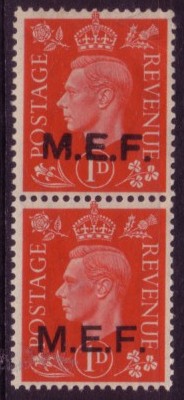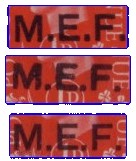Middle East Forces (MEF)
The British occupying forces originally used normal unoverprinted British stamps, but in 1942 overprinted them "MEF" (Middle East Forces). An earlier proposal had been to overprint them "MELF" (Middle East Land Forces). These were first released in north east Africa in Eritrea (March 1942) and in Italian Somaliland (13 April 1942); then in 1943 they were also released on the African Mediterranean in Cyrenaica and Tripolitania (now both in Libya), and eventually in the Greek Dodecanese Islands in 1945. A truly enormous geographical spread.
The MEF stamps were gradually replaced by overprinted issues for individual areas - see under East Africa Forces (1943), Eritrea (1948), Somalia (1948), Tripolitania (1948) - except for the Dodecanese Islands which continued to use MEF stamps until the end of the occupation in 1947, and Cyrenaica which had a new design inscribed with the territory name in 1950. As implied by the overprint the stamps were intended for use by military personnel rather than primarily as a public service.
There is much mystery surrounding the first issues. It is known that Harrisons overprinted the 1943 (pale colours + 5d) set, but it is not known for sure who printed the 1942 sets (dark colours + 5d), which appear to have been overprinted locally on British stamps already in the stores. The commonest "dark colours" set, with a nice clean 14mm overprint (used in Eritrea and Somalia), is now thought to have been overprinted by the Army Printing Services in Cairo and not (as previously thought) by Harrisons; the other "dark colours" set (used only in Eritrea), with a mixture of a nice clean 13½mm overprint alternating with a very rough font, is now commonly listed as being prepared by "an unidentified printer in the MEF area". Alternative printers proposed for the latter include McCorquodales and a Greek printer in Cairo by the name of Murafatli. One report has the issue being printed in the back of an Army lorry near Nairobi. It is a matter of some note that a stamp issue prepared officially by the somewhat bureaucratic British army, and in use for nine months, should have no records of its place of printing.
In the 13½mm issue referred to above, the lines of overprint are either in clean letters or in rough letters. But it is not simply alternate rows: the clean overprint is in rows 2, 3, 7 of each 6*10 pane, with the rough overprint on the other rows. This leads to the ironical situation that se-tenant pairs of the two overprints are keenly sought after (and highly priced) but are actually slightly commoner than vertical pairs with the same overprint on each: if you remove the 3 se-tenant pairs from a column (1+2,3+4,7+8) you are left with two pairs of rough overprints (5+6,9+10), and there is only one way of making a pair of smooth overprints (destroying two adjacent se-tenant pairs).
From 23 August 1950 the GPO permitted the use in the UK of any overprinted stamps which did not alter the face value. MEF stamps can therefore be found with UK postmarks, and are fully legitimate items, but sell for much less than those with postmarks from the relevant area.
For forerunners prepared in 1941 for use in Eritrea, Ethopia and Somalia (but not issued) see under Somalia.
All stamps overprinted "M.E.F."
Note: this numbering system was drawn up by the Society for the website, and may not be used without permission.
There are 4 distinguishable types for values 1d-5d
(a) local issues (14mm x just under 3½ mm) [Eritrea, Somalia]
(b) local issue (13½mm x just over 3mm) [Eritrea]
- (b1) stamps with square stops
- (b2) stamps with round stops
(c) Harrison issue (13½mm, oblong stops) [Eritrea, Cyrenaica, Tripolitania, Dodecanese Is]
Only the 5d presents a real problem with identification, between rare type (b1, No. 10) and common type (c, No. 20), though the dark colours of the 2½d and 3d can sometimes be difficult to distinguish against the dark background.
King George VI
(a) local issue, 14mm x just under 3½ mm
(Eritrea & Somalia)
2 March 1942

1 1d red
2 2d orange
3 2½d blue
4 3d violet
5 5d brown
overprint varieties
1 v1 1d, left leg of "M" sliced diagonally
2 v1 2d, left leg of "M" sliced diagonally
3 v1 2½d, left leg of "M" sliced diagonally
4 v1 3d, left leg of "M" sliced diagonally
5 v1 5d, left leg of "M" sliced diagonally
top: 14mm x just under 3½ mm, stop halfway between "E" and "F"
middle: 13½mm x just over 3mm round stops
bottom: 13½mm x just over 3mm square stops, stop between "E" and "F" is nearer the "E".
(b) local issue, 13½mm x just over 3mm
(Eritrea)
(b1) stamps with square stops
 (image from unidentified auction)
(image from unidentified auction)
6 1d red
7 2d orange
8 2½d blue
9 3d violet
10 5d brown
Note: this stamp is often confused with the common type (c) below
(b2) stamps with round stops
11 1d red
12 2d orange
13 2½d blue
14 3d violet
15 5d brown
overprint varieties

6 v1 1d se-tenant type b1, b2
7 v1 2d se-tenant type b1, b2
8 v1 2½d se-tenant type b1, b2
9 v1 3d se-tenant type b1, b2
9 v2 3d overprint double, type b2
Note: in some earlier listings this was given as a double type (a) overprint: as the doubling is almost coincident it appears large and misshapen so misidentification is easy. "Kiss prints" are more common and should not be confused with the genuine double overprint.
10 v1 5d se-tenant type b1, b2
(type c) Harrison overprint issue, 13½mm, oblong stops
(Eritrea, Cyrenaica, Tripolitania, Dodecanese Is)
Note: these were not issued in Somalia, where the EAF stamps were now in use.
pale colour low values, higher values, postage dues
1 January 1943


16 1d pale red
17 2d pale orange
18 2½d pale blue
19 3d pale violet
20 5d brown
Note: often mistakenly identified as the rarer type (b1, No. 10) above
21 6d purple
22 9d green
23 1/- brown
24 2/6d green
25 5/- red
26 10/- blue
Postage dues
watermark sideways

27 ½d green
28 1d red
29 2d black
30 3d violet
31 1/- blue
page last updated on: 28 December 2006, 7 June 2014, 21 August 2017
gbos: GB Overprints Society

